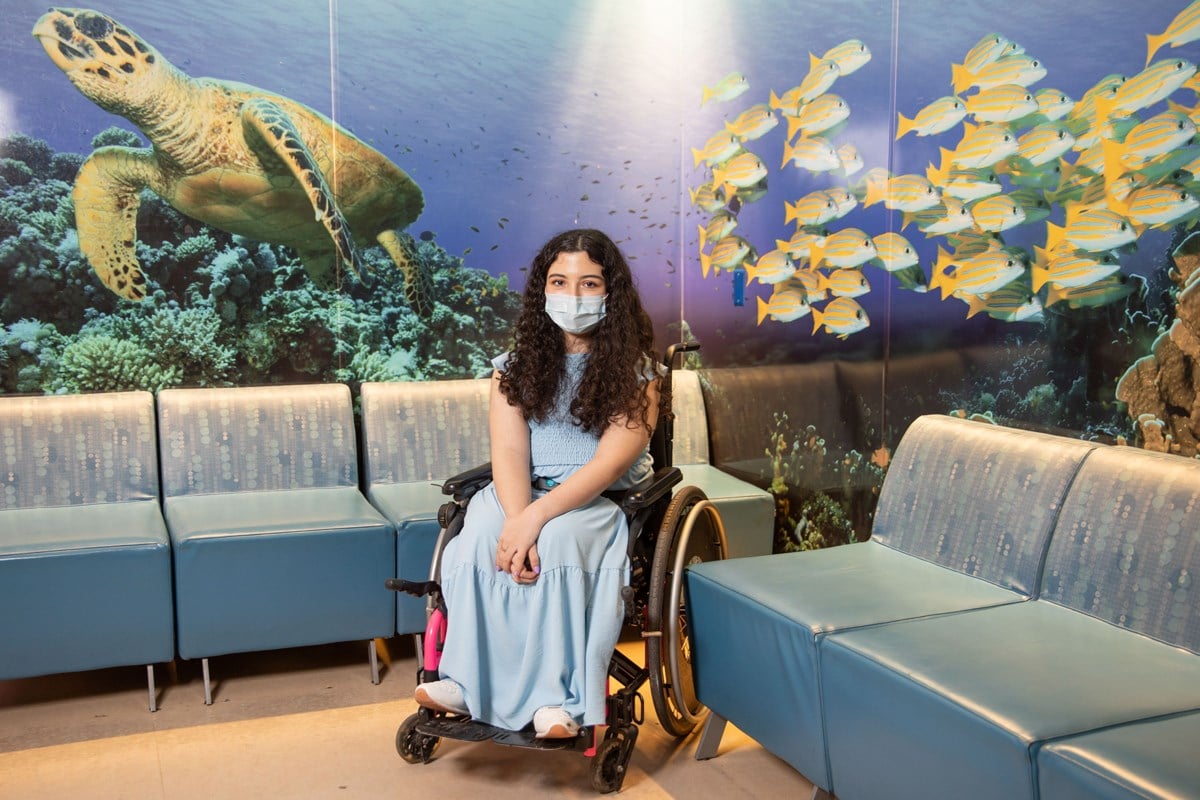Melika Ghanaati on growing up at SickKids and her journey for answers
Summary:
Long-time patient Melika Ghanaati shares her ongoing journey to diagnosis, and what SickKids has meant to her.
In some ways, Melika Ghanaati is like many other young adults. She loves listening to music, especially Taylor Swift and Selena Gomez. She’s interested in skincare and makeup, and recently discovered the wonders of a caramel iced coffee with espresso cold foam.
Unlike many other young adults, Melika has seen the inside of the surgical suite at SickKids over 15 times. Her journey with SickKids spans 15+ years, and her childhood is deeply intertwined with the happenings in the hospital.
“My parents knew from the moment I was born that something wasn’t right,” she says. “I had club feet and trouble breastfeeding. Slowly they noticed other signs that pointed towards some kind of muscle problem.”
Her family immigrated to Canada from Iran in 2009 – in part to access the care that SickKids could provide. She’s been followed by the SickKids Orthopaedics, Urology, Nephrology, Respirology, Genetics, Neurology and Cardiology teams ever since.

Her journey, like many people with an undiagnosed rare condition, has been lengthy and full of many ups and downs.
“I have a complex diagnosis list, she says.
Club feet, congenital muscle weakness, asthma, kidney stones, impact to fine monitor skills, sleep apnea, and scoliosis have been a handful of the conditions she has been treated for over the past 15 years.
She has had three major surgeries on her spine alone to treat the scoliosis. She has used a wheelchair since the last spinal surgery because she lost a lot of her muscle strength and has to work with a physiotherapist to regain it.
“I pretty much grew up at SickKids,” Melika says. Procedures aside, it’s the SickKids Atrium Fountain where she tossed coins and made wishes, the Orthopaedic Surgery and Otolaryngology Unit (5A), the 5A playroom and the pre-operative surgical waiting room (Same Day Admit Unit or SDAU) where she’s had some of her most formative childhood memories.

SickKids Atrium Fountain
When I was young, I would throw coins in the Atrium Fountain and make silly little wishes. As I grew older, the wishes changed.... I wish they’ll find a vein easily today; I wish I could start to feel better.

Orthopaedic Surgery and Otolaryngology Unit (5A)
Despite some of my hardest memories taking place on 5A, the staff and volunteers always made me feel safe. One time when I returned to the unit there was a sign that said "Welcome back, Melika!"

5A Playroom
I would gravitate towards this cupboard to play games. Books were harder if I had an IV in my arm, but also, I enjoyed the interaction that games provided.

Pre-op surgical waiting room (SDAU)
Most often I was terrified to be here knowing a surgery was coming, but SickKids staff always knew how to make it a little less scary. For a few of my more recent surgeries, they played Selena Gomez for me as they brought me into the surgical suite.
Despite the long and complex diagnostic journey she’s been on, Melika is still waiting – and determined – to find answers.
“I have big questions about what my life will hold,” she says. “For example, will I be able to have kids one day? Having questions like that and never knowing how to plan for your future is frustrating.”
Precision Child Health aims to help close gap in undiagnosed conditions
In October 2022, Melika’s care team told her that all the standard clinical options had been explored in finding a diagnosis, but hope was not lost. They turned to clinical research opportunities to charge ahead. In July 2023, she enrolled in a study called SickKidsSeq, a research initiative within the SickKids Precision Child Health (PCH) movement that broadens access to genome sequencing for patients and families who can’t access it through standard clinical care.
A key focus of the PCH movement is working to close the gap in undiagnosed conditions and finding answers for patients like Melika. Genome sequencing can help identify the genetic causes of both rare and common medical conditions, unlocking the potential to uncover other key factors that can facilitate diagnosis, and guide the individualized care that is a hallmark of precision medicine.
Even so, genome sequencing only yields answers around 30 per cent of the time – a figure SickKids is trying to improve by investing in innovative research, tools, technology and leveraging the expertise needed to move the dial.
For Melika, it didn’t reveal a genetic cause or diagnosis...but it did move her further along in her journey to understand her condition.

“Using genome sequencing allows us to look at all genes at once,” says Anna Szuto, Translational Genomics Program Manager and Melika’s Genetic Counsellor. “This approach allowed our research team to identify a variant in a gene that we would not have otherwise specifically sought to test.”
“The variant we found is currently classified as a variant of uncertain significance (VUS),” she explains. “The ‘maybes’ associated with VUS remain a big challenge for patients with rare diseases. Next in our quest to provide Melika with answers, we’ll use RNA sequencing, which allows us to look at how the body interprets the genetic code rather than looking directly at the genetic code itself. RNA sequencing is one of the approaches that we can deploy to help resolve some types of uncertainty.”
Both Melika and her care team are invested in unlocking more pieces of the complex puzzle that makes up her condition. The goal is to help her move into the next stage of life, and transition to adult care, with confidence.
“Being close to a diagnosis – it's kind of like pouring water over a fire,” Melika says. “It’s exciting to feel closer to an answer I’ve spent my whole life looking for.”

